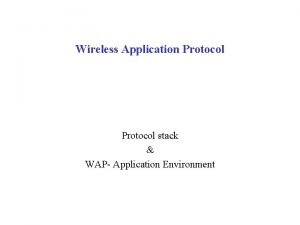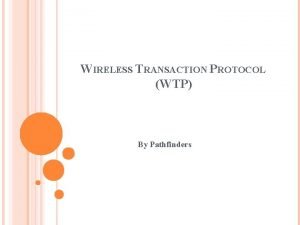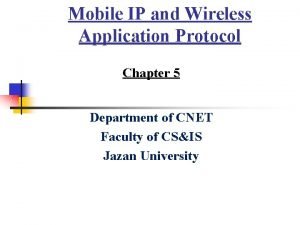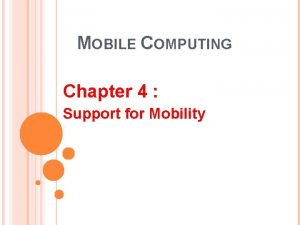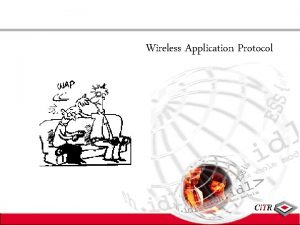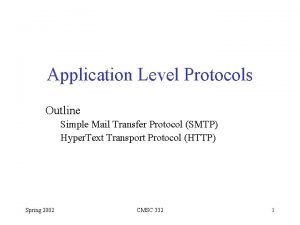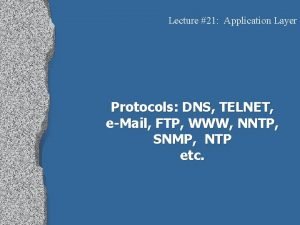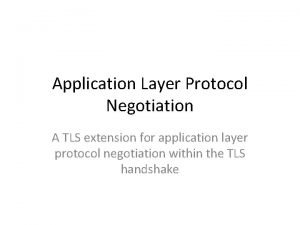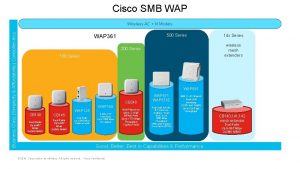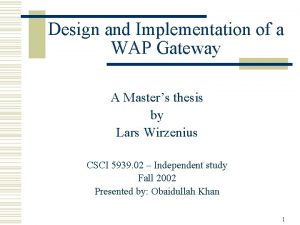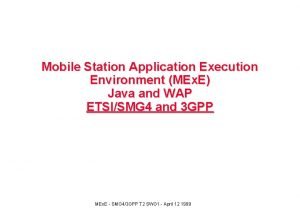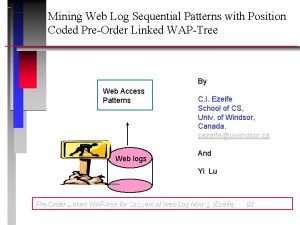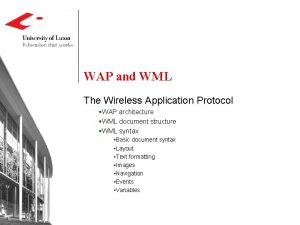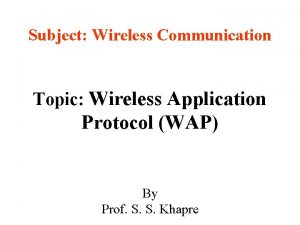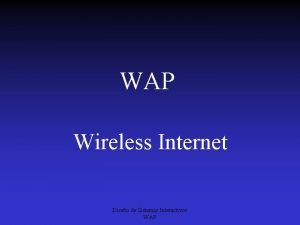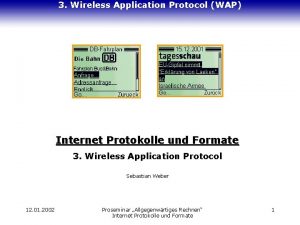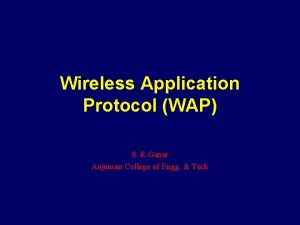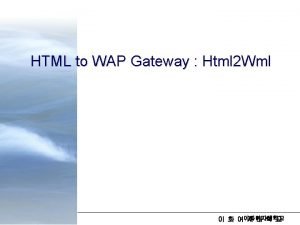Wireless Application Protocol WAP Definition of WAP Wireless


























- Slides: 26

Wireless Application Protocol (WAP)

Definition of WAP Wireless application protocol (WAP) is an application environment and set of communication protocols for wireless devices designed to enable access to the Internet and advanced telephony services to the wireless community. n n Develop By WAP Forum, Summer 1997 WAP 1. 0 Standard, 1998 n n n Open Standard Industry-Wide Specification WAP 2. 0 Standard, 2002

What is WAP n WAP – The Wireless Application Protocol n n Makes it possible to access the Internet via wireless devices such as mobile phones, PDAs etc. Set of rules governing transmission/reception of data by wireless devices (e. g. mobile phones)

Limitations of Internet for Wireless Applications n Traditional Internet applications cannot run on mobile devices because of the following limitations: n n n n Low bandwidth network High Latency network Limited connection stability Small display size Limited input facility Limited memory Limited processing power

Limitations of Internet for Wireless Applications n Low bandwidth n n n Size of an HTML page, including graphics Download time (56 Kbps modem) Bandwidth of wireless network 9. 6 Kbps Download time for data on one page … 20 KB … 3 s … … 17 s High latency n n n At the expiry of retransmission timer value, the TCP layer resends the packet of data An average latency in a wireless network is around ½ s but can be as high as 10 s This can cause a lot of retransmission causing severe congestion

Limitations of Internet for Wireless Applications n n n Limited connection stability Small display size Limited input facility Limited memory Limited processing power

What can be done with WAP? n. Information services n. Similar to web browsing n. Small downloadable programs n. WAP script language is based on Java. Script™ n. Telephony functionality combined with browser n. Call the airline when your flight is delayed n. Push n. Server initiated content push

What is defined in WAP? n Layered telecommunication stack including n. Datagrams and Transactions n. Security n. Session n Micro browser n. Concept that is similar to the Internet browsing n. XML based markup language ( WML ) n. Scripting ( WMLS ) n WTA / WTAI n. Access to telephone functionality n Content formats e. g. n. Service Indication n. Wireless Bitmap ( WBMP )

WAP Architecture WAP Gateway WMLScript WTAI Etc. Web Server WML Encoder WSP/WTP WMLScript Compiler Protocol Adapters HTTP CGI Scripts etc. Content WML Decks with WML-Script Client

How It Works 7 Client 2 Request Encrypted URL Request WMLScript Etc. Response Encrypted WML Content 4 HTTP Request xxx wml Web Server WAP Gateway WML WTAI 3 Encoder, Decode r WMLScript Compiler Protocol Adapters CGI Scripts etc. HTTP Response xxx wml 6 5 WAP HTTP WML Decks with WML-Script 1 Static file or CGI Output WML Content

Internet and WAP architecture Internet Wireless Application Protocol HTML Java. Script™ Other Services and Applications Wireless Application Environment (WAE) Wireless Session Layer (WSP) HTTP Wireless Transaction Protocol (WTP) TLS - SSL TCP/IP UDP/IP Wireless Transport Layer Security (WTLS) Wireless Datagram Protocol (WDP) Bearers: SMS USSD CSD R-Data Packet UDP PDC-P Etc. . .

WAP & Standards n n Submit specifications for adoption by appropriate industry and standards bodies Good relationships with standards bodies n n Several Liaisons with ETSI / WAP compliance profile for GSM and UMTS. CTIA official Liaison Officer to the WAP Forum WAP is actively working with the W 3 C and IETF

WAP Protocol Stack Wireless Session Service Access Point n Developed by n n Wireless Protocols Group (WPG) A WAP technical working group. Wireless Session Protocol Wireless Transaction Service Access Point Wireless Transaction Protocol Transport Service Access Point (TSAP) Wireless Datagram Protocol WCMP Bearer Service Bearer Service D C Service B A Physical Layer Air Link Technology

WAP Protocols Recall the ISO OSI model: • WAE (Wireless Application Environment): WML, WML Script • WSP (Wireless Session Protocol) and WTP (Wireless Transaction Protocol): together provide session layer services connection oriented sessions or connectionless sessions. Reliable sessions can be resumed. • WTLS (Wireless Transport Layer Security) (Optional)

WAP Protocol Stack - WSP n n Provides shared state between client and server used to optimize content transfer Provides semantics and mechanisms based on HTTP 1. 1 Enhancements for WAE, wireless networks and “low-end” devices Enhancements beyond HTTP n n n Binary header encoding Confirmed and non-confirmed data push Capability negotiation Suspend and resume Connectionless service

WAP Protocol Stack - WSP n Binary header encoding n n n Capabilities n n n Compact binary encoding of headers, content type identifiers and other well-known textual or structured values Reduces the data actually sent over the network Message Size, client and server Protocol Options: Confirmed Push Facility, Session Suspend Facility, Acknowledgement headers Maximum Outstanding Requests Extended Methods Header Code Pages Suspend & Resume n Allows the release of underlying bearer resources

WAP Protocol Stack - WSP n Connection & Connectionless service n Connection-mode n n Long-lived communication Benefits of the session state Reliability Connectionless n n n Stateless applications No session creation overhead No reliability overhead

WAP Protocol Stack - WTP n Reliable data transfer based on request/reply paradigm n n No explicit connection setup or tear down Data carried in first packet of protocol exchange Seeks to reduce 3 -way handshake on initial request Supports n n n n retransmission of lost packets selective-retransmission segmentation / re-assembly port number addressing (UDP ports numbers) flow control abort function for outstanding requests concatenation of PDUs Message oriented (not stream)

WAP Protocol Stack - WTLS n n Specifies a framework for secure connections, using protocol elements from common Internet security protocols like SSL and TLS. Provides connection security for two communicating applications n n n Privacy (encryption) Data integrity (MACs) Authentication (public-key and symmetric) Lightweight and efficient protocol with respect to bandwidth, memory and processing power Employs special adapted mechanisms for wireless usage n n n Long lived secure sessions Optimised handshake procedures Provides simple data reliability for operation over datagram bearers

WAP Protocol Stack - WDP n n WDP provides a connection-less, unreliable datagram service WDP is adapted to each particular wireless network to provide the generic datagram transport. The basic datagram service is fundamental to all wireless networks and makes it possible to utilize WAP everywhere Replaced by UDP when used over an IP network layer. n n WDP over IP is UDP/IP Uses the Service Primitive n T-Unit. Data. req. ind

WAP Protocol Stack - Bearer support n n n n n GSM SMS, USSD, C-S Data, GPRS IS-136 R-Data, C-S Data, Packet CDMA SMS, C-S Data PDC C-S Data, Packet PHS C-S Data CDPD i. DEN SMS, C-S Data, Packet FLEX and Re. FLEX Data. TAC

WAP: Applications n Location-based services n n Enterprise solutions n n n Schedules and rescheduling, Reservations Gaming and Entertainment n n n Banking, Bill-paying, Stock trading, Funds transfers Travel services n n Email access, Database access, “global” intranet access Information updates “pushed” to WAP devices Financial services n n Real-time traffic reporting, Event/restaurant recommendation Online, real-time, multi-player games Downloadable horoscopes, cartoons, quotes, advice M-Commerce n n n Shopping on the go Instant comparison shopping Location-based special offers and sales

FUTURE OF WAP n n Will WAP comply with Third Generation wireless standards? Yes, WAP has been designed to be as independent as possible from the underlying network technology. Is WAP necessary with higher bandwidth 3 G networks? Even as bandwidths increase, the cost of that bandwidth does not fall to zero. These costs result from higher power usage in the terminals, higher costs in the radio sections, greater use of RF spectrum, and increased network loading. In addition, the original constraints WAP was designed for -- intermittent coverage, small screens, low power consumption, wide scalability over bearers and devices, and one-handed operation -- are still valid in 3 G networks. Finally, we can expect the bandwidth required by application users to steadily increase. Therefore, there is still a need to optimize the device and network resources for wireless environments. We can expect WAP to optimize support for multimedia applications that continue to be relevant.

FUTURE OF WAP n If WAP is very successful in mass-markets on 2. 5 G networks, 3 G networks may be needed purely for capacity relief. n The reasons to migrate to WAP technology n Network operators are behind WAP n n n With minimal risk and investment, WAP enables operators to decrease churn, cut costs, and increase revenues by improving existing, value-added services and offering exciting new informational services. Why are equipment manufacturers interested in WAP? Being a global open specification suite, WAP has generated the critical mass for manufacturers. This has opened up new product and marketing opportunities in the wireless industry and provides new revenue to participating companies.

ADVANTAGES • open standard, vendor independent • network-standard independent • • transport mechanism–optimized for wireless data bearers application downloaded from the server, enabling fast service creation and introduction, as opposed to embedded software

DISADVANTAGES of WAP n n n Small screens: For web phones, there's an incredibly small viewing area; palmtops are barely better. Speed of access: All devices have slow access. Limited or fragmented availability: Wireless web access is sporadic in many areas and entirely unavailable in other areas. Price: Many technology limitations are being addressed by higher-end devices and services. But the entry price for a good wireless web palmtop with decent display, keyboard, and speed is easily $700 to $900, not including monthly access. Lack of user habit: It takes some patience and overcoming the learning curve to get the hang of it -- connecting, putting in an address, typing. Users just aren't used to the idea and protocol yet.
 Wta logical architecture
Wta logical architecture Telecommunications, the internet, and wireless technology
Telecommunications, the internet, and wireless technology Wireless transaction
Wireless transaction Wtls in mobile computing
Wtls in mobile computing Session mobility in mobile computing
Session mobility in mobile computing Android wireless application development
Android wireless application development A deck in wireless application
A deck in wireless application Application level protocol
Application level protocol Snmp
Snmp Application layer protocol negotiation
Application layer protocol negotiation Wap casino games
Wap casino games Wap browser
Wap browser Wandering atrial pacemaker rhythm
Wandering atrial pacemaker rhythm Wap 361
Wap 361 Wap trailer
Wap trailer Wap
Wap Wap sfm
Wap sfm Faktor kedatangan kuasa asing
Faktor kedatangan kuasa asing Desy wap
Desy wap Wap treck
Wap treck Wap notification
Wap notification Wap com games
Wap com games Wap web
Wap web Wap web
Wap web Wap web
Wap web Wap alternatives
Wap alternatives Wap
Wap
